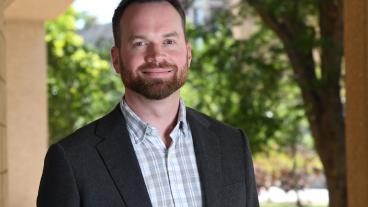Computer science professor looks to bridge the interoperability gap in cities


We often see it in science fiction films: entire cities that operate with an interconnected ecosystem of smart technology that seamlessly shares data to communicate across a vast network of devices and platforms to maximize efficiencies. These “smart cities” enable a wide array of capabilities that the average person doesn’t even have to think about on a day-to-day basis, such as transportation and access to essential resources. Implicit in this vision is the idea of interoperability—the ability of disparate technologies and systems to interact with one another.
But while we don’t yet live in that sci-fi ecosystem, researchers are working on ways to make that a reality, but integrating this interoperability is more complicated than you might think. It all comes down to semantics.
To use data to understand a large area of an existing built environment, such as cities, buildings and transportation systems, having a good digital representation of that system is necessary. “We need a metadata model, which is a digital description of how the system is put together, how it works, what devices are there and what data they produce,” said Gabriel Fierro, assistant professor of computer science.
Buildings are responsible for 40 percent of the energy consumption in the U.S., so they are a particularly rich target for innovations in energy management. However, there isn’t a standard way for describing building systems. Many older buildings have no digital description, and while many modern buildings contain Internet of Things systems, the lack of a standard means that computers aren’t able to interpret that data effectively. Fierro is working on a project to change that by developing a standard way of describing buildings and their data to make it easier to develop software for them.
Fierro said the key to modeling a complex system in a consistent way is to figure out which details matter and which don’t—similar to how you can plug any keyboard, mouse or monitor into your computer and it will still work regardless of what kind of processor or operating system you have.
“I can write the software once and then deploy it for millions and millions of buildings and get the same benefits as if an expert had been there to curate the experience for each building,” he said. “Having these consistent digital descriptions of this infrastructure makes it possible to provide management in a more distributed fashion without having to involve experts at every level. The software can essentially configure itself to run in a new building without any human intervention, similar to how an automatic car knows how to shift gears at the right time without the driver having to know when to move it back and forth.”
This semantic interoperability would allow for easier software development to provide better energy efficiency, optimize system performance and automatically identify and diagnose faults. This lowers costs for building owners who buy the software, as well as the developers who create it.
Fierro said, “Going forward, I hope to see critical physical infrastructure adopt more modern data management practices so we have greater insight into how these systems are operating. Eventually it would be interesting to explore the idea of municipal data as a public utility.”




